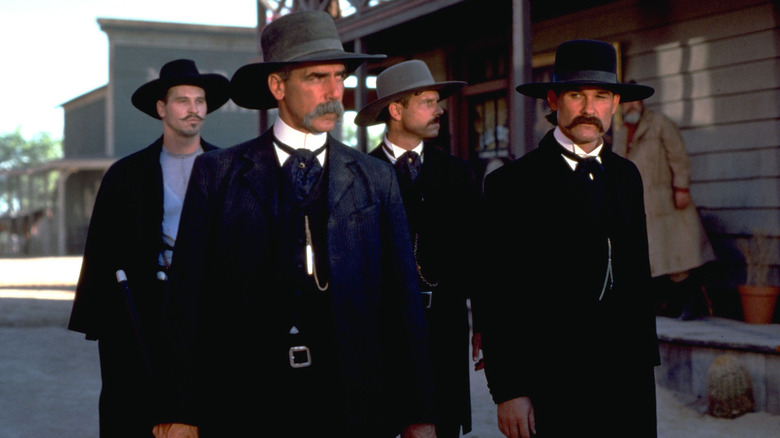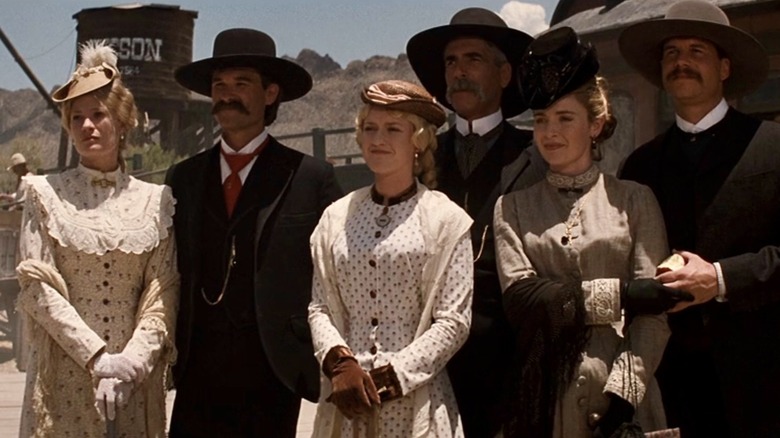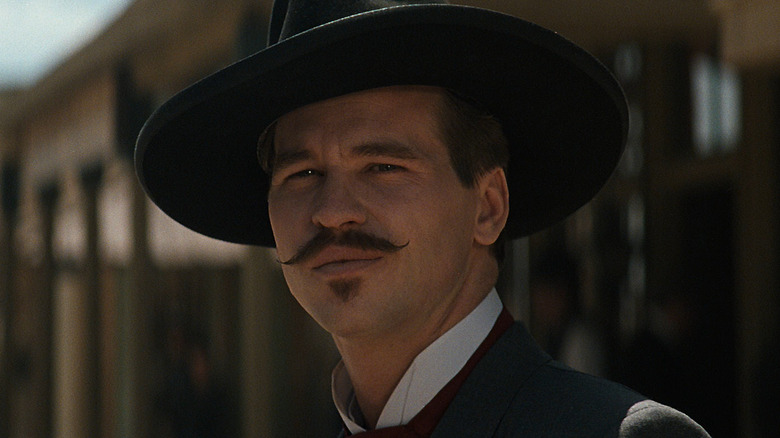How Historically Accurate Is Tombstone?
As a Western based on real events, "Tombstone" was made with an eye toward historical accuracy, with all but one actor, for instance, growing out a real mustache, to be waxed and curled up in accordance with period photos. Not everything that transpires in "Tombstone" is in line with what really happened, however. The movie documents the feud that erupted between the family of "legendary lawman" Wyatt Earp (Kurt Russell) and a gang of local cowboys in Tombstone, Arizona, in the late 1800s, with tensions spilling over into the famous gunfight at the O.K. Corral and the ensuing Earp Vendetta Ride. Unsurprisingly, though, in compressing a multi-year story down to 130 minutes, "Tombstone" takes some liberties with the timeline of events.
According to MovieWeb, much of the colorful dialogue in "Tombstone" — such as the line from Val Kilmer's tuberculosis-ridden Doc Holliday, "You're a daisy if you do" — is pulled from real newspaper reports. Less accurate is the film's depiction of the Earp family's arrival in Tombstone. OldWest.org indicates that the brothers — including one Jim Earp, who the movie leaves out entirely — staggered their arrival over a period of several months, from late 1879 to mid-1880.
By contrast, the film shows Wyatt riding the train into Tucson, where he and his wife meet up with Virgil (Sam Elliott), Morgan (Bill Paxton), and their wives. The three couples then admire themselves in the window before they board a covered wagon and all ride into Tombstone together at the same time.
In the eponymous silver mining town, where he plans to make his fortune, "Tombstone" shows Wyatt being met by local lawman Johnny Behan (Jon Tenney), who introduces himself as "Cochise County Sheriff." In reality, Cochise County was founded in February 1881, and Earp and Behan ran for sheriff against each other.
Tombstone fudges the timeline and homages John Ford
"Tombstone" takes a page from "The Godfather Part III" ("Just when I thought I was out, they pull me back in"), playing up Wyatt Earp's retirement and reluctance to get drawn back into law enforcement for dramatic effect. The truth is, Virgil Earp was already a deputy U.S. Marshal before he came to Tombstone, while Wyatt and Morgan had been specially deputized on more than one occasion before Wyatt ran for sheriff.
The movie also shows the Bird Cage Theater in the background when the Earps ride into town, and later we see Wyatt's future wife, Josephine Marcus (Dana Delaney), and her traveling theater troupe perform there. According to the book "The Making of Tombstone: Behind the Scenes of the Classic Modern Western" (via OldWest.org), "Tombstone" screenwriter and original director Kevin Jarre first planned to have the troupe's performance take place at Schieffelin Hall, where it probably occurred in real-life. After visiting the real Tombstone, he changed his mind and decided to use the Bird Cage Theater as the venue instead.
The real Bird Cage Theater wasn't established until December 1881, over a month after the gunfight at the O.K. Corral. By then, marshal Fred White was long since dead, having been gunned down in October 1880 by Curly Bill Brocious (Powers Boothe). "Tombstone" ages up the thirtysomething White and has actor Harry Carey Jr. portray him, likely as a tribute to filmmaker John Ford. Carey was a regular of Ford Westerns like "The Searchers," which also inspired HBO's "Westworld."
Actor Michael Biehn later told Setting History Straight that Jarre's firing led to a paring down of the script, which sanded off Wyatt's rough edges and turned the cowboys from "rounded characters" into a "one-note band of black-hatted desperados."
Doc Holliday: maybe not your Huckleberry, after all
The book "Wyatt Earp: The Life Behind the Legend" (per OldWest.org) indicates that tensions between Earp and Ike Clanton (Stephen Lang) mounted after a botched scheme that would have seen Clanton give up three other cattle rustlers for reward money. In the movie, Clanton is seen dunking his head in a water barrel right before the O.K. Corral shootout, and because he's unarmed, he manages to escape with his life — though not before grabbing a gun and firing off some rounds from a window to avenge his brother Billy's death.
Though the shootout escalated owing to his previous threats, the real Ike never picked up a gun as it unfolded. It was also over in a mere 30 seconds, in contrast to the heightened movie version, where it's a solid minute and a half from the firing of the first to the last shot. "Tombstone" further conflates the attempt on Virgil Earp's life and the death of Morgan Earp into a single attack, when in reality, they were two separate events that took place in December 1881 and March 1882, respectively.
Perhaps most surprisingly, the epic showdown between Doc "I'm Your Huckleberry" Holliday and Johnny Ringo (Michael Biehn) at the end of "Tombstone" appears to be a cinematic invention, part of an increased body count that the movie delivers as part of its spin on the Earp Vendetta Ride. There's evidence to suggest the real Holliday was hundreds of miles away and that Johnny Ringo was depressed and had died by suicide before his corpse was found in a canyon in July 1882. Wyatt Earp didn't really appear by Holliday's deathbed, either, as the two men reportedly last met a year or two before Holliday finally expired (in 1887).
"Tombstone" is currently streaming on Paramount+.


